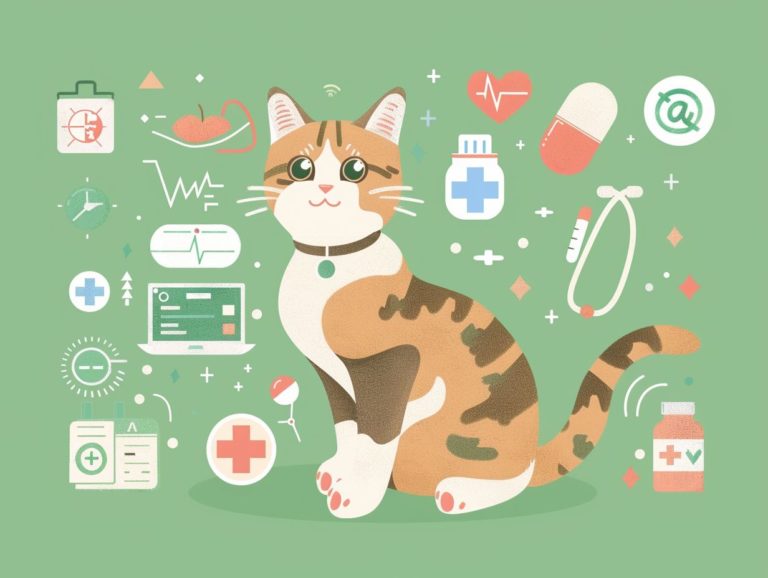Whats Not Covered Exclusions In Cat Health Insurance
Cat health insurance is essential for ensuring that cats receive the necessary care without causing financial concerns for their owners. It is crucial to understand what is covered and excluded in these policies.
Common exclusions in cat health insurance typically involve pre-existing conditions, behavioral issues, and elective procedures. Finding the right cat health insurance policy involves thorough research, comparison of policies, and consideration of key coverage factors.
Key Takeaways:
Understanding Cat Health Insurance Coverage
Cat Health Insurance Coverage is an essential safeguard for pet owners looking to protect both the health of their feline companions and their finances. Pet insurance for cats encompasses a range of medical expenses, including veterinary visits, surgeries, medications, and emergency treatments. By investing in cat health insurance, owners can avoid bearing the full burden of costly veterinary procedures.
Various coverage options offer different price points, coverage limits, deductible amounts, and exclusions. Some policies even provide additional benefits for wellness exams and preventive care. The cost of a cat insurance plan is influenced by several factors, such as the cat’s age, breed, location, hereditary and congenital conditions, coverage limits, deductibles, and any additional benefits or riders included in the policy.
What is Covered?
Cat health insurance typically covers a range of medical expenses, including treatment for illnesses, accident-related injuries, vaccinations, wellness care, and preventive measures. Most policies also include coverage for medical conditions like hyperthyroidism, diabetes, kidney disease, and cancer treatments.
Many cat insurance plans offer preventive care services such as annual check-ups, dental cleanings, and parasite control as part of their services. Regular veterinary check-ups are essential for early detection and treatment of potential health issues and for ensuring the overall well-being of the cat. Cat health insurance that encompasses these services provides comprehensive coverage for a variety of health concerns.
What is Not Covered?
The main exclusions in cat health insurance policies are pre-existing conditions, age or breed-specific restrictions, elective procedures, and administrative costs not included in basic plans. Pre-existing conditions are generally not covered, referring to any illness or disease your cat exhibited signs of before the policy waiting period, typically 14 days. Age or breed-specific restrictions may limit coverage options for certain breeds or older cats. Elective procedures like cosmetic surgeries or behavioral training are often not included in basic cat health insurance plans. Additionally, administrative expenses such as filing fees and processing costs are typically not covered under standard cat health insurance policies.
Common Exclusions in Cat Health Insurance
The most common exclusions in cat health insurance policies are pre-existing conditions, behavioral issues, elective procedures, and pregnancy-related complications. Pre-existing conditions refer to medical conditions or symptoms that your cat had before obtaining the insurance policy. Behavioral issues, such as aggression or destructive behavior, are typically excluded from coverage. Elective procedures, like cosmetic surgeries or grooming, are not included in most basic plans. Pregnancy-related complications are often considered part of the normal breeding process and are therefore excluded from coverage. Exclusions related to congenital conditions, specific diseases, and other conditions may vary, so it is essential to thoroughly review the policy.
Pre-Existing Conditions
Pre-existing conditions in cat health insurance refer to any illnesses or injuries that existed prior to the insurance policy’s effective date, and are typically excluded from coverage to prevent fraud and maintain the policy’s integrity. These conditions can pose challenges for pet owners seeking coverage for their cats.
It is not possible to obtain coverage for pre-existing conditions, so pet owners should be aware of these limitations and explore alternative methods for managing their pet’s existing conditions. One option is to select a comprehensive insurance policy that covers new conditions arising after the waiting period. Another approach is to collaborate with a veterinarian to develop a proactive health management plan aimed at minimizing the impact of pre-existing conditions on the overall health of a cat.
Behavioral Issues
Behavioral issues in cats pose significant challenges for pet owners, yet they are frequently excluded from traditional pet insurance coverage due to their diverse and unpredictable nature. While most pet insurance policies cover accidents and illnesses, the spectrum of behavioral problems in cats is often not classified as medical conditions.
Cats may exhibit aggression, anxiety, inappropriate urination, and destructive scratching, stemming from various factors such as stress, trauma, or underlying health issues. Managing these behaviors typically involves behavior modification, environmental enrichment, and occasionally seeking assistance from a veterinary behaviorist. It is crucial for pet owners to collaborate with their veterinarian to identify and address behavioral concerns promptly, and to explore alternative financial options to address these specific issues.
Elective Procedures
Cat health insurance policies typically do not cover elective procedures, which refer to voluntary cosmetic surgeries or non-emergency treatments deemed not medically necessary. Despite not being covered by cat insurance, it is essential for owners to understand the significance of these treatments.
Common examples of elective procedures in veterinary medicine include dental cleanings, tumor removals, and spaying/neutering surgeries. While these procedures may not be considered medically necessary, they play a crucial role in maintaining a cat’s overall health and can prevent future complications.
In instances where pet insurance excludes coverage for elective procedures, pet owners can explore alternative financing options such as pet-specific loans, payment plans, or establishing a pet healthcare savings account.
How to Find the Right Cat Health Insurance Policy
Choosing the best cat health insurance policy requires an in-depth understanding of the features of various policies, necessitating a thorough search and comparison of available options. The ideal cat insurance policy is one that aligns with both the cat’s needs and the owner’s budget. This involves a detailed analysis of coverage limits, deductibles, reimbursement percentages, and any exclusions present in each policy. It is also important to assess the reputation and financial stability of the pet insurance provider and ensure compliance with all U.S. regulations. Trusted entities such as the American Animal Hospital Association (AAHA) may offer recommendations for insurers that adhere to industry standards. Carefully reviewing policy documents and asking pertinent questions prior to purchase will enable you to make an informed and appropriate decision for your cat’s healthcare.
Researching and Comparing Policies
To find the most suitable cat health insurance policy for your cat’s health needs and financial situation, it is essential to research and compare different policies. This involves evaluating coverage options, premiums, deductibles, and limitations of various policies.
Begin your research by gathering information from veterinary clinics, pet insurance websites, and pet owner forums to familiarize yourself with the available coverage types. Factors such as your cat’s age, breed, pre-existing conditions, and specific health requirements should be taken into account when comparing policies.
Look for key features like annual limits, reimbursement levels, waiting periods, and coverage for routine care or hereditary conditions. Utilize resources such as the North American Pet Health Insurance Association (NAPHIA) for insights on industry standards, customer feedback, and claims processes to aid in selecting the most suitable cat health insurance policy.
Considerations for Choosing Coverage
- Cat health insurance coverage should encompass vaccinations, wellness exams, and potential administrative expenses. When selecting a policy, ensure it offers comprehensive care without unexpected financial burdens by considering the following factors in coverage exclusions to watch out for in senior cat insurance:
- Inclusion of preventive care services, such as annual examinations, dental cleanings, and parasite prevention, to maintain your cat’s health.
- Coverage for vaccinations, which are essential to safeguard your cat against common and potentially deadly infectious diseases.
- Transparency in the insurance plan regarding administrative expenses, as these costs are a significant part of the total expense of cat health insurance. The variation in administrative expenses across different insurance policies can impact your budget, underscoring the importance of considering this factor when choosing a policy.
Frequently Asked Questions
What’s Not Covered in Cat Health Insurance?
Cat health insurance typically does not cover pre-existing conditions, cosmetic procedures, or breeding costs.
Are vaccinations covered under cat health insurance?
In most cases, routine vaccinations are not covered by cat health insurance. However, some plans may offer additional coverage for certain vaccines.
Can I get coverage for hereditary or genetic conditions for my cat?
It depends on the insurance provider and plan. Some may offer coverage for hereditary or genetic conditions, while others may exclude them from coverage.
Will my cat’s age affect the coverage in their health insurance?
Yes, most cat health insurance plans have age restrictions and may not cover cats over a certain age. It’s important to review the policy details before enrolling your cat.
What are some common exclusions in cat health insurance?
Some common exclusions in cat health insurance include dental care, pre-existing conditions, behavioral issues, and alternative therapies.
What should I do if my cat has a pre-existing condition?
If your cat has a pre-existing condition, it may not be covered by a new insurance policy. It’s important to disclose any pre-existing conditions when enrolling in cat health insurance to avoid coverage denial or cancellation in the future.




